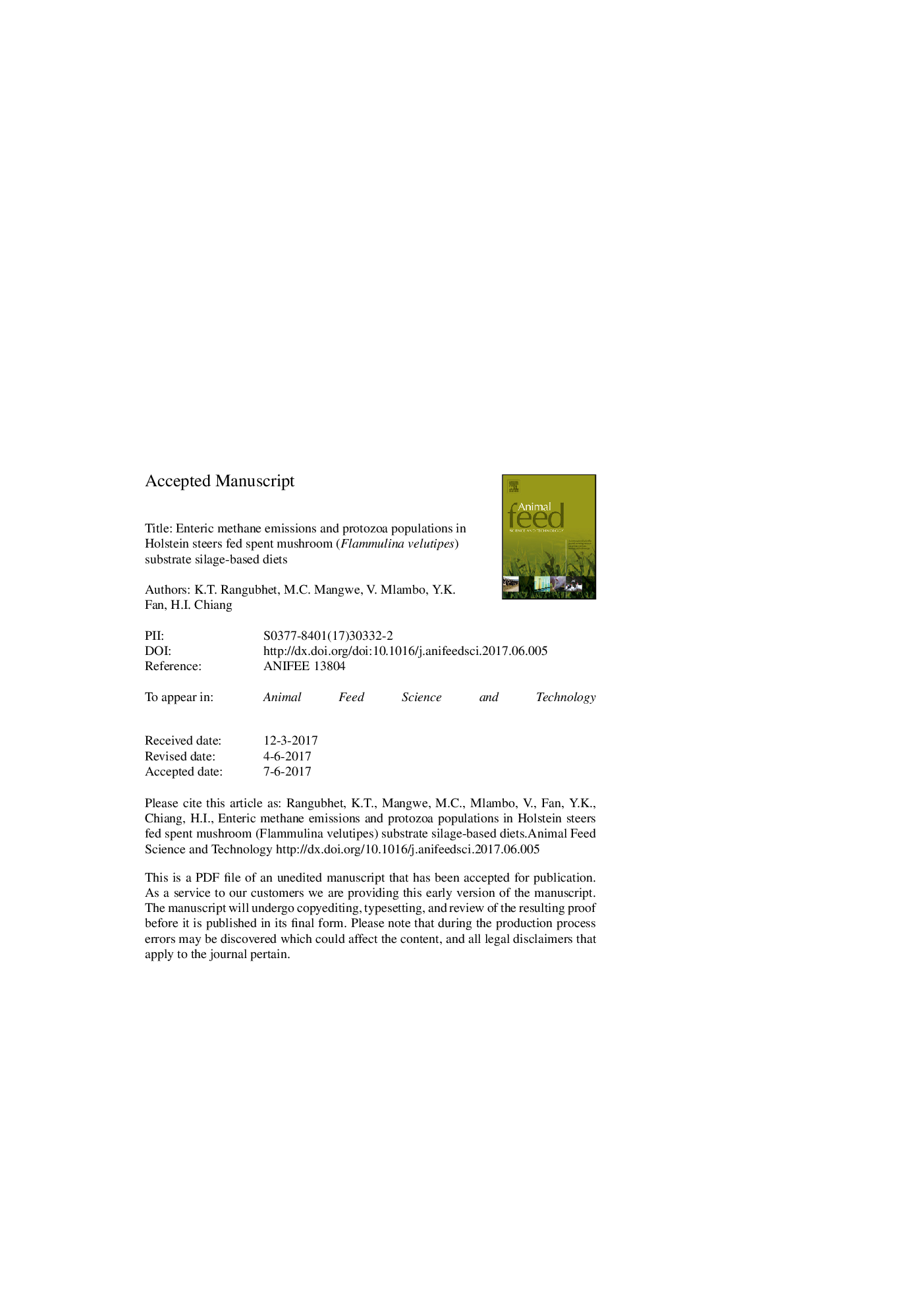| کد مقاله | کد نشریه | سال انتشار | مقاله انگلیسی | نسخه تمام متن |
|---|---|---|---|---|
| 5538713 | 1552352 | 2017 | 29 صفحه PDF | دانلود رایگان |
عنوان انگلیسی مقاله ISI
Enteric methane emissions and protozoa populations in Holstein steers fed spent mushroom (Flammulina velutipes) substrate silage-based diets
دانلود مقاله + سفارش ترجمه
دانلود مقاله ISI انگلیسی
رایگان برای ایرانیان
کلمات کلیدی
ADLADFaNDFNFCacid detergent fiber - الیاف پاک کننده اسیدgross energy - انرژی ناخالصSpent mushroom substrate - بستر قارچ مصرفیProtozoa - تکیاختگانSilage - سیلوether extract - عصاره اترNon-fiber carbohydrate - غیر فیبر کربوهیدراتneutral detergent fiber - فیبر مواد شوینده خنثیorganic matter - ماده آلیdry matter - ماده خشکEnteric methane - متان انتهاییSteer - هدایتcrude protein - پروتئین خامSMS - پیامک
موضوعات مرتبط
علوم زیستی و بیوفناوری
علوم کشاورزی و بیولوژیک
علوم دامی و جانورشناسی
پیش نمایش صفحه اول مقاله

چکیده انگلیسی
Direct modification of rumen microbial fermentation could provide universal and cost-effective solutions to reduce methane emissions from ruminant livestock. In this study, the effect of feeding spent mushroom (golden needle mushroom, Flammulina velutipes) substrate (SMS)-based silage supplemented with or without urea on the enteric methane emission and total rumen protozoa populations in Holstein steers was investigated. Spent mushroom substrate and whole crop corn were ensiled for 60 days with or without urea as follows: Silage 1 (SMS 900 g/kg and whole crop corn 100 g/kg); Silage 2 (SMS 900 g/kg, urea 10 g/kg and whole crop corn 90 g/kg); Silage 3 (SMS 800 g/kg and whole crop corn 200 g/kg); Silage 4 (SMS 800 g/kg, urea 10 g/kg and whole crop corn 190 g/kg) on dry matter (DM) basis. Five dietary treatments were prepared as follows: 1) a control diet made-up of 500 g/kg of concentrate and 500 g/kg of bermuda hay (Cynodon dectylon), and 2) four diets formulated by replacing 400 g/kg of the bermuda hay in the control diet with the four SMS-based silages described above. Five Holstein steers (mean BW 542 ± 72 kg) were assigned to a 5 Ã 5 Latin square design in which the five dietary treatments were offered across 5 periods, with 14 days of adaptation plus 7 days of samples collection in each period. Holstein steers fed diets containing SMS-based silages had lower total protozoa population (3.37 Ã 105/mL vs. 6.09 Ã 105/mL), rumen acetate (55.43 mM/L vs. 57.08 mM/L) and methane emission (211 g/day vs. 252 g/day) (P < 0.05) than Holstein steers fed control diet. When comparing the inclusion levels of SMS-based silages in the diets, cattle fed diets of lower levels of SMS-based silages (800 g/kg of SMS) had higher acetate contents (56.61 mM/L vs. 54.25), protozoa population (3.92 Ã 105/mL vs. 2.84 Ã 105/mL) and methane emission (226 g/day vs. 196 g/day) than heifers fed diets of higher levels of SMS-based silage (900 g/kg of SMS). The study demonstrates that feeding Holstein steers with SMS-based silage significantly decreases protozoa populations in the rumen and enteric methane emission. Although the mechanisms are not fully understood, the phytochemicals in SMS could be responsible for the reduction in rumen protozoa populations and the inhibition of rumen methanogenesis.
ناشر
Database: Elsevier - ScienceDirect (ساینس دایرکت)
Journal: Animal Feed Science and Technology - Volume 234, December 2017, Pages 78-87
Journal: Animal Feed Science and Technology - Volume 234, December 2017, Pages 78-87
نویسندگان
K.T. Rangubhet, M.C. Mangwe, V. Mlambo, Y.K. Fan, H.I. Chiang,